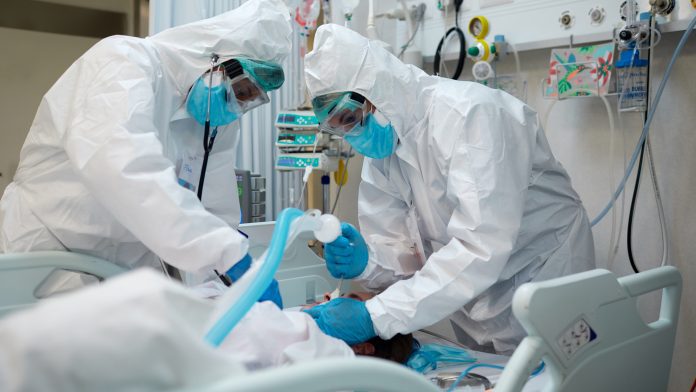
A research team from the US Centres for Disease Control and Prevention (CDC) has released data regarding COVID-19 among healthcare professionals and explained how to reduce exposure and risk during a future virus outbreak.
The CDC has released the first assessment of reported COVID-19 exposures over time among US healthcare personnel (HCP) during the global pandemic. Findings from the study imply that HCPs diagnosed with Covid were more likely to be exposed to SARS-CoV-2 in their workplaces, as COVID-29 cases increased in their communities. Additionally, the CDC insists these findings also offer insights for reducing HCP exposure and risks during a potential future virus outbreak.
This study was published in The American Journal of Infection Control.
How was data collected during this study?
“Previous reports hypothesised that COVID-19 incidence among HCPs was primarily a result of non-occupational exposures because HCP who lived in communities with higher COVID-19 incidence were more likely to become infected with SARS-CoV-2,” explained Rachael M. Billock, first author, PhD, CDC COVID-19 Response Team.
“Our findings suggest that, particularly during periods of high community incidence of COVID-19, HCP exposures occur both at the workplace and outside of it, with the workplace being a major driver of infections. These results emphasise the continued need for improved infection prevention and control measures in occupational settings, as well as the need for improved surveillance to identify and reduce occupational exposures to SARS-CoV-2 among HCPs and all workers during a potential future virus outbreak.”
HCPs experienced significant SARS-CoV-2 risk during the virus outbreak of the COVID-19 pandemic. Through May 2021, 500,000 COVID-19 diagnoses and 1,653 deaths in the US. HCPs were reported to the CDC, and HCP cases and deaths are known to be undercounted. The study conducted by Dr Billock and colleagues identified the settings in which HCPs were exposed to COVID-19 over time and the relationship between community incidence of COVID-19 and HCP case exposure settings.
What findings were discovered from this virus outbreak?
Additionally, utilising national, de-identified COVID-19 surveillance data for HCPs that were diagnosed with COVID-19 and reported COVID-19 exposure between 1 March 2020, to 31 March 2021, were evaluated by various variables present during the virus outbreak.
These included exposure setting (healthcare-associated/workplace, home, or community), exposure trends over time, the correlation between COVID-19 incidence in communities and HCP exposure setting, and the impact of the national vaccination programme. Key findings included:
COVID-19 Case Trends Over Time
- During the specified period, 83,775 HCP diagnosed with COVID-19 with known COVID-19 exposure settings were reported to the CDC;
- Reported COVID-19 cases and deaths among HCPs increased rapidly in March 2020. Case counts peaked in early April, July, and December 2020; and
- Similarly, deaths were most frequent among HCP cases with the earliest associated dates in April 2020 and reached a secondary peak in December 2020-January 2021.
COVID-19 Exposure Setting
- Between March 2020 and March 2021, HCPs with COVID-19 were more likely to report known exposures to SARS-CoV-2 in the workplace (52%), compared to their household (30.8%) or community (25.6%);
- The proportion of HCP cases reporting healthcare-associated (i.e., workplace) exposures during the virus outbreak peaked in April 2020 at 84% and declined in May and June 2020;
- Approximately two-thirds of HCPs with COVID-19 who reported exposure on the job and specific exposure types also reported exposures to patients with COVID-19 and other HCPs with COVID-19. This finding underscores the importance of improved infection prevention and control (IPC) measures to address transmission through all healthcare-associated routes, including co-worker to co-worker, during a future virus outbreak; and
- The largest reductions in workplace exposures were observed early in the pandemic (June 2020) following the introduction of improved IPC measures and later in December 2020, following the initiation of the national COVID-19 HCP vaccination programme.
Correlation Between Workplace Exposure and Community Prevalence
- The CDC study revealed that heightened community incidences of COVID-19 were associated with greater numbers of HCPs with COVID-19 reporting workplace virus outbreak exposures and fewer reporting household or community exposures;
- HCP cases were more likely to report healthcare exposures (aPR = 1.31; 95% CI: 1.26-1.36) and less likely to report household and/or community exposures (aPR = 0.73; 95% CI: 0.70-0.76) under the highest vs lowest community incidence levels; and
- Despite researchers’ hypothesis that there would be a positive association between community incidence and healthcare-associated exposure prevalence at the start of the virus outbreak, the proportion of HCPs diagnosed with COVID-19 who were exposed to COVID-19 at work continued to trend with community COVID-19 incidence. This is despite the researchers’ expectation that the trend would reverse over time as healthcare workplaces implemented improved IPC measures and some community preventive measures were relaxed. This association was maintained until vaccination programmes began in December 2020, emphasising that even improved IPC measures were not wholly sufficient to protect HCPs from occupational exposures during periods of high community incidence during the virus outbreak.
Impact of the National Vaccination Programme
- Following the initiation of the national HCP COVID-19 vaccination program in mid-December 2020, researchers observed a sharp decline in HCPs diagnosed with COVID-19 during the virus outbreak. From December 2020 through March 2021, healthcare-associated exposures flipped from the most commonly reported exposure type among HCP to the least; and
- These findings suggest that HCPs, regardless of personal vaccination status, may have experienced reduced workplace exposures due to early vaccination among co-workers and some patient populations.
“This study provides important insights to guide infection prevention and control practices in healthcare settings so that we can better protect HCPs and their patients,” concluded Linda Dickey, RN, MPH, CIC, FAPIC, and 2022 APIC president. “Additionally, it reiterates the importance of collecting data on HCP work-related variables during a virus outbreak, such as industry, occupation, and workplace exposures, in infectious disease surveillance.”










